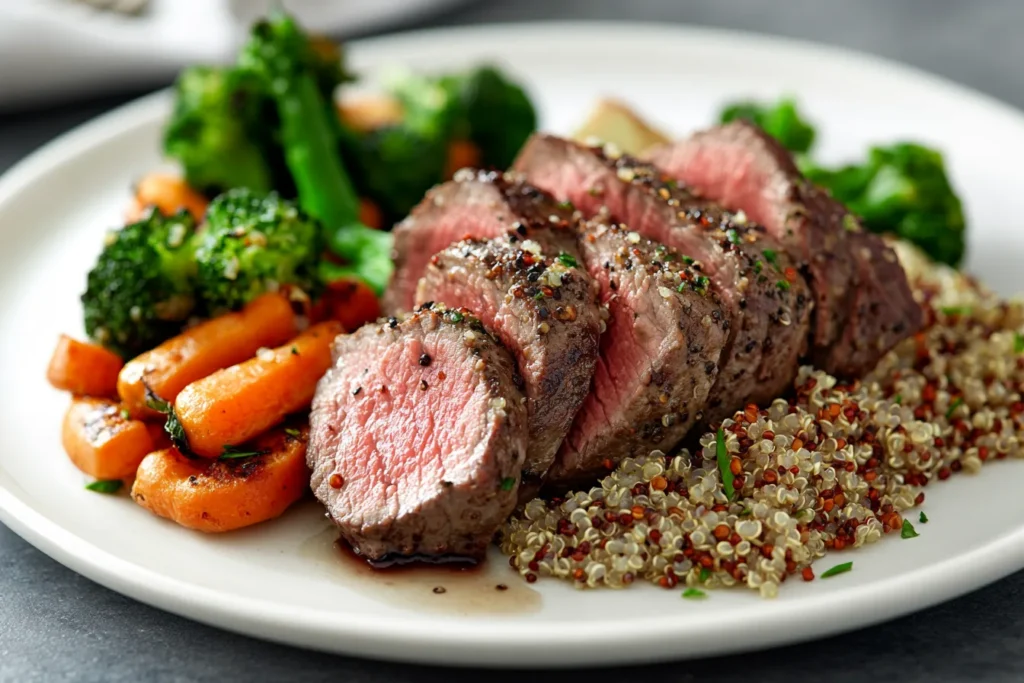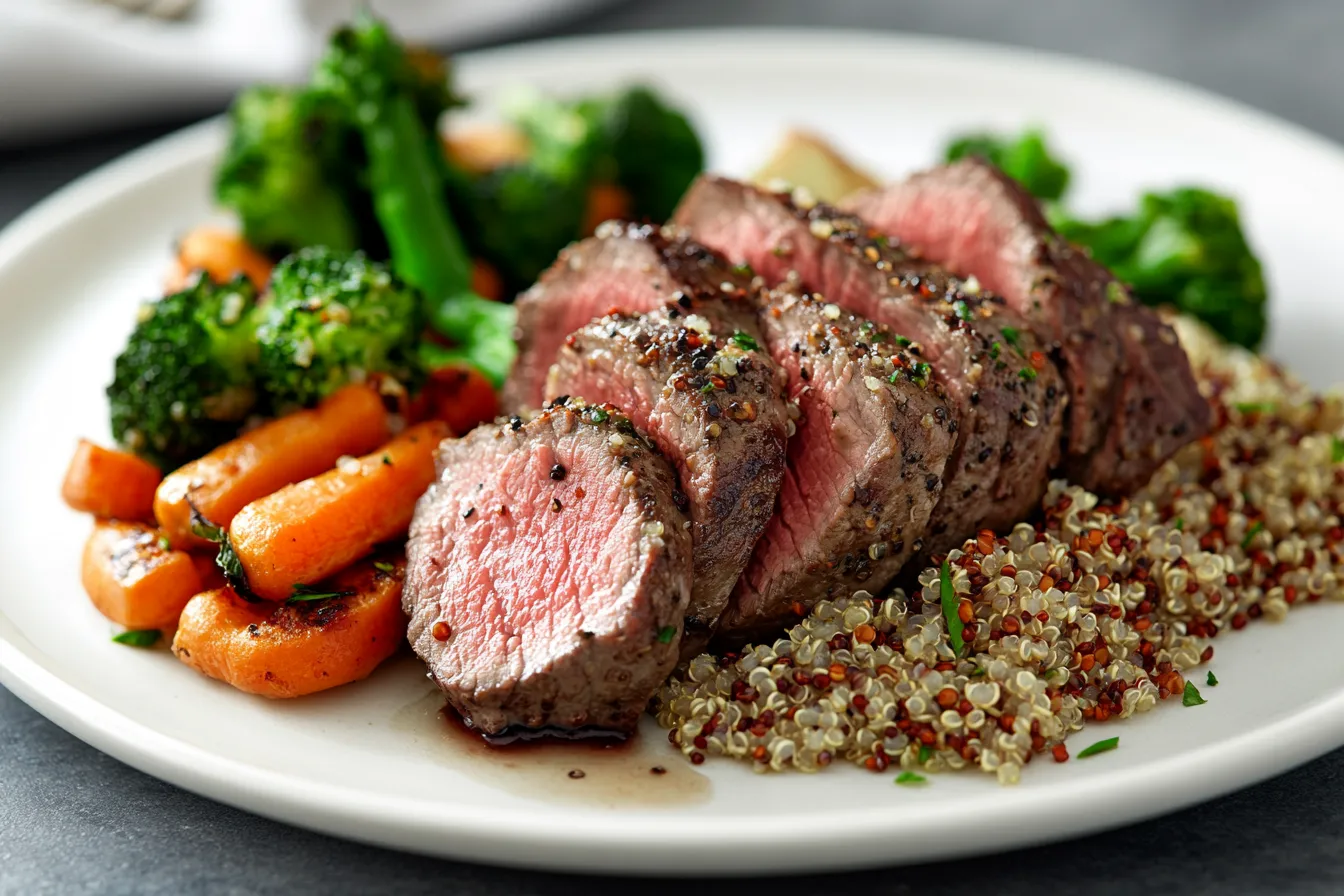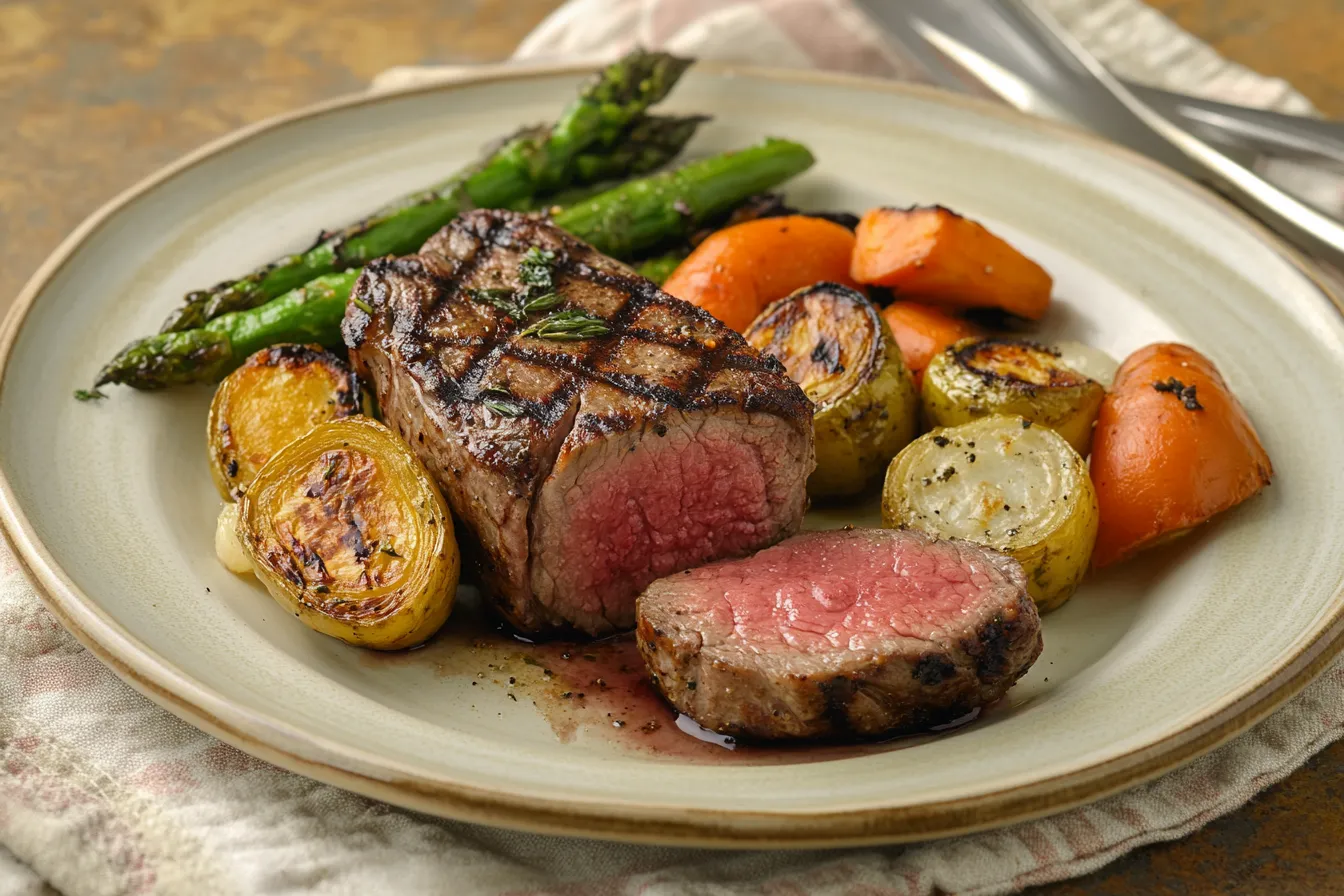Table of Contents
Introduction
Let’s be honest—we all love a good steak. And when it comes to fine dining or special family dinners, beef tenderloin is usually the star of the show. But amid all the sizzle and flavor, one question keeps popping up:
“Is beef tenderloin actually good for you?”
The answer might surprise you. In this article, we’re diving into the nutritional value of beef tenderloin, breaking down what makes this premium cut of beef not just tasty, but also beneficial (and sometimes questionable) for your health. Whether you’re a health-conscious foodie, a gym-goer looking for clean protein, or someone who just wants to eat smarter—this one’s for you.
So grab your fork, and let’s carve into the details! 🥩

What Is Beef Tenderloin?
A Butcher’s Perspective: Where It Comes From
Beef tenderloin comes from the loin section of the cow, tucked between the sirloin and the short loin. It’s a long, cylindrical muscle known as the psoas major—and guess what? It does very little work in the cow’s daily life. That’s why it’s so tender, hence the name..Carnivore Diet Recipes
This cut is prized for its melt-in-your-mouth texture and low connective tissue, making it a top choice for fine cuts like filet mignon, Chateaubriand, and tournedos.
🧠 “Fun fact: The tenderloin is one of the most expensive cuts of beef because it only makes up about 2-3% of the cow’s total weight!”
Why It’s Considered a Premium Cut
Beef tenderloin isn’t just tender—it’s also lean, versatile, and elegant. Whether grilled, roasted, or pan-seared, it offers a refined texture without being too fatty. It’s the kind of meat that makes guests go, “Wow!”—and makes your nutritionist slightly raise an eyebrow.
But is it worth the hype nutritionally? Let’s find out.
Nutritional Breakdown of Beef Tenderloin
When people hear “red meat,” they often think fat, cholesterol, and heart problems. But beef tenderloin tells a different story—let’s take a look at the nutrition facts per 100g (3.5 oz) serving.
🧾 Nutrition Facts Table: Beef Tenderloin (100g, Cooked)
| Nutrient | Amount |
|---|---|
| Calories | 250 kcal |
| Protein | 26g |
| Total Fat | 17g |
| Saturated Fat | 6.8g |
| Monounsaturated Fat | 7g |
| Polyunsaturated Fat | 0.6g |
| Cholesterol | 85mg |
| Iron | 2.6mg (14% DV) |
| Zinc | 4.5mg (41% DV) |
| Vitamin B12 | 2.5µg (104% DV) |
| Vitamin B6 | 0.4mg (24% DV) |
| Phosphorus | 198mg (28% DV) |
| Selenium | 33µg (60% DV) |
DV = Daily Value, based on a 2,000-calorie diet.
Calories and Macronutrients (Protein, Fats, Carbs)
Tenderloin is a low-carb, high-protein food—perfect for keto diets, muscle building, or just clean eating.
- Protein: With 26 grams of protein per serving, it supports muscle repair, tissue regeneration, and even helps you feel full longer.
- Fat: Yes, tenderloin contains fat—mostly healthy fats, including monounsaturated fats, the kind that benefit heart health. Compared to ribeye, it’s significantly leaner.
- Carbs: Zero. Nada. Zip. That’s right—no carbohydrates, making it a friend of keto-lovers everywhere. 🥑
Vitamins and Minerals in Beef Tenderloin
Tenderloin isn’t just protein and fat—it’s also a micronutrient powerhouse.
- Iron helps oxygenate your blood and keep energy levels up.
- Zinc supports immune function and metabolism.
- Vitamin B12 & B6? Essential for brain health, red blood cell production, and a happy nervous system.
- Selenium & Phosphorus? They aid in thyroid health and strong bones.
❝When you bite into a piece of tenderloin, you’re not just tasting luxury—you’re fueling your body with essential nutrients.❞
Comparison with Other Cuts (Sirloin, Ribeye, etc.)
| Cut | Calories (100g) | Fat | Protein |
|---|---|---|---|
| Tenderloin | 250 kcal | 17g | 26g |
| Sirloin | 271 kcal | 19g | 25g |
| Ribeye | 291 kcal | 23g | 24g |
| Brisket | 300+ kcal | 25g | 22g |
👉 As you can see, tenderloin is one of the leanest cuts—lower in fat than ribeye or brisket, while still packing protein and taste.

Health Benefits of Beef Tenderloin
High-Quality Protein for Muscle Growth 💪
Your muscles love protein, especially when it comes from complete animal sources. The amino acids in beef tenderloin are bioavailable, meaning your body uses them efficiently for building lean mass, repairing tissues, and staying energized..Healthy Ground Beef
Whether you’re hitting the gym or recovering from a workout, beef tenderloin gives you the power-up you need.
Iron and Zinc for Immunity and Energy
Red meat often gets a bad rap, but let’s give credit where it’s due—iron and zinc in tenderloin are highly absorbable compared to plant sources.
- Iron: Prevents fatigue and boosts oxygen transport in your blood.
- Zinc: Supports immune function, wound healing, and hormone balance.
Think of these nutrients as your body’s built-in maintenance crew 🧰—keeping your system humming along smoothly.
B Vitamins for Brain and Heart Health 🧠❤️
Beef tenderloin is rich in Vitamin B12 and B6, which play a major role in:
- Supporting mental clarity
- Reducing homocysteine levels (linked to heart disease)
- Promoting healthy red blood cell production
“A juicy steak now and then might do more for your brain than another cup of coffee!” ☕
Common Misconceptions About Beef Tenderloin
Let’s clear the air, shall we? Beef tenderloin might be delicious, but there are plenty of myths and misconceptions floating around it. So let’s play “Fact or Fiction” and bust a few of these.
“It’s Too Fatty to Be Healthy” – Myth Busted
❌ Fiction. People often lump all red meat together as “unhealthy,” but beef tenderloin is one of the leanest cuts available. Compared to a marbled ribeye or fatty brisket, tenderloin contains less saturated fat and total calories.
“It’s like comparing a scoop of gelato to a tub of ice cream—similar in nature, vastly different in calories.”
The key is portion control and cooking method. Pan-seared with olive oil and herbs? 👌 Grilled with a bunch of butter and bacon? Well… you get the picture. 😅
Grass-Fed vs. Grain-Fed: Is There a Difference?
Absolutely, yes!
| Aspect | Grass-Fed | Grain-Fed |
|---|---|---|
| Fat Content | Leaner, more omega-3s | Slightly fattier, more marbling |
| Flavor | Earthy, sometimes gamey | Richer, buttery taste |
| Nutrients | More vitamin E, A, and antioxidants | Lower in micronutrients overall |
| Price | Usually more expensive | More affordable |
Grass-fed tenderloin tends to have better omega-3 to omega-6 ratios, which may support heart health. So if you’re health-focused (and don’t mind spending a bit more), grass-fed is a smart pick.
Potential Health Concerns and How to Handle Them
Now that we’ve hyped up all the good stuff, let’s be real. Even tenderloin, lean as it is, comes with a few health caveats.
Cholesterol & Saturated Fats – Should You Worry?
This is the elephant in the room. Red meat has been linked to high cholesterol and heart disease—but context matters…Burger Pass
A 100g serving of tenderloin has 85mg of cholesterol and about 6.8g of saturated fat. That’s within the recommended daily limits for most adults.
“It’s not about eating beef—it’s about how often and how much.”
✅ Tips to reduce risk:
- Limit intake to 2-3 servings per week
- Pair it with fiber-rich veggies and whole grains
- Avoid frying or overcooking (no charred bits, please)
Tips for Healthier Preparation Methods 🧑🍳
How you cook your tenderloin can make or break its nutrition.
Here are some chef-approved, heart-happy cooking methods:
- Grill or broil it with minimal oil
- Roast with garlic, rosemary, and lemon zest 🍋
- Sous vide to keep moisture without fat
- Pan-sear with olive oil, then finish in the oven
🧠 “Avoid smothering it in butter, sauces, or bacon—unless it’s cheat day!”
How to Include Beef Tenderloin in a Balanced Diet
Yes, you can absolutely enjoy tenderloin without guilt—it’s all about balance and smart planning.
Recommended Serving Size
Stick to a 3–4 ounce cooked portion (about the size of your palm). That’s enough protein and iron for most people without overloading on calories.
Overdoing it? You might feel sluggish and risk nutrient imbalance.
Best Pairings with Veggies & Whole Grains 🥦🍚
Don’t let your steak fly solo—surround it with:
- Steamed or roasted veggies (broccoli, carrots, asparagus)
- Whole grains (quinoa, farro, brown rice)
- Leafy greens for extra iron absorption (thanks, spinach!)
“Think of beef tenderloin as the headliner in a band—it shines best when supported by the rest of the group.”

Frequently Asked Questions
Is beef tenderloin better than ribeye nutritionally?
Yes! Tenderloin is leaner and has fewer calories and saturated fats, while still offering great protein and essential vitamins.
How often should I eat red meat like tenderloin?
Nutritionists recommend 2–3 times per week if you’re healthy and active. Balance with poultry, fish, and plant proteins for variety.
What’s the leanest cut of beef?
Tenderloin is among the leanest, but eye of round and sirloin tip side steak are even leaner (but less tender).
Can kids and elderly eat beef tenderloin safely?
Absolutely! Just be sure it’s properly cooked (medium or well-done), and cut into manageable pieces for easy chewing and digestion.
How to cook it for max nutrition?
Grill, broil, or roast. Skip the frying and use herbs instead of salt-heavy seasonings. Try a cast iron sear with garlic and thyme!
Is beef tenderloin keto-friendly?
Yes! It’s zero-carb and high in healthy fats and protein, making it a perfect fit for keto or low-carb diets.
Conclusion
Beef tenderloin isn’t just a fancy cut of meat—it’s a nutritional gem when enjoyed in moderation. With 26g of protein, a wealth of B vitamins, and iron and zinc galore, it fuels your body while pleasing your palate.
Of course, like any food, the key is balance. Enjoy your tenderloin alongside greens and grains, cooked in a heart-smart way, and you’ll savor not just the taste—but the health benefits, too.
“So next time someone tells you steak is bad for you, hand them a fork and say: ‘Try this.’” 😄

Beef Tenderloin Nutritional Value
Ingredients
Equipment
Method
- Trim the tenderloin: Remove silver skin and excess fat with a sharp knife.
- Season the beef: Rub with olive oil, garlic, salt, pepper, rosemary, and thyme.
- Preheat your oven (or grill) to 425°F (220°C).
- Sear the meat: In a hot skillet, sear all sides for 2–3 minutes to lock in juices.
- Roast the tenderloin: Transfer to the oven and cook until the internal temperature reaches 130°F (medium-rare) or 140°F (medium), about 20–25 minutes.
- Rest the meat: Cover loosely with foil and let it rest for 10 minutes before slicing.
- Slice & serve: Cut into 1-inch medallions and serve with steamed vegetables or whole grains.

